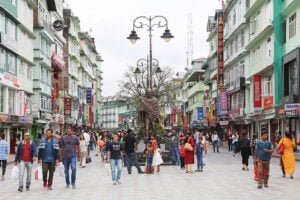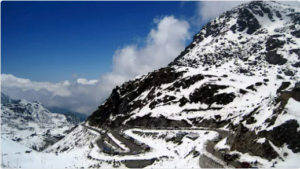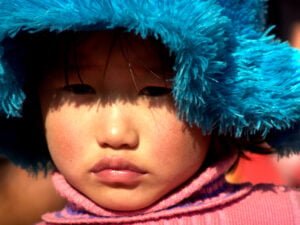No products in the cart.
SIKKIM SOJOURN- HEAVENLY ADVENTURES IN THE HIMALAYAS
Sikkim
This tiny Himalayan state of the Indian Union, for its original inhabitants, the Lepcha community was ‘Nye-mae-el’ or simply heaven. And any visitor arriving in these glorious nature-bound environs couldn’t agree more. Its easy sprawl of over 7,096 sq km, remarked for the stunning upper Teesta valley is bounded on the south by West Bengal. The Singhalila Range serves as a natural barrier with Nepal in the west while the Dongkya Range aligns its eastern borderlands with the Tibet Autonomous Region of China. Dominating the Himalayan landscape of snow-bound ranges is mighty Mt. Khanchendzonga, India’s first and the world’s third-highest peak. Mountaineering is strictly prohibited as the venerable peak is the abode of Sikkim’s guardian deity. Nature worshippers, the Lepchas are considered to be the disciples of Khanchendzonga.
The Lepchas were the original inhabitants of Sikkim before the Bhutia community arrived in these pristine, remote lands and decided to settle here. The three ethnic groups in Sikkim- Lepchas, Bhutias, and Nepalese a mosaic of diverse cultures, traditions, and religions, enhancing the visitor experience exponentially. While over the centuries the synergy between these ethnicities has been pivotal in creating the quintessential Sikkimese Culture, each community has steadfastly continued to preserve its own identity which is mirrored in their places of worship, festivals, cuisine, music and dance, and dress traditions
Tradition has it that in the 14th century Khye Bumsa, a prince from the Minyak House in Kham in eastern Tibet, was directed by divine revelation to head south to make his fortunes. In 1642. Phuntsog Namgyal, his fifth-generation descendant rose to become the founder of Sikkim’s monarchy. Phuntsog Namgyal was consecrated as the first Chogyal or religious king of Sikkim, by the three highly revered lamas at Yuksom, the first capital of Sikkim. From 1642 to 1975 Sikkim was an independent Buddhist Kingdom under Namgyal – Chogyal dynasty. In May of 1975, Sikkim merged with India on 16th May 1975 as its 22nd state.
GANGTOK 
The buzz and bustle of the state capital offer an endearing insight into the warmth and hospitable ambiance of this culturally rich Himalayan abode. From various vantage points in town, you will catch views of some of the most compelling panoramas of Mt Khanchendzonga the abode of Sikkim’s protective deity which stands guard over the hill town.
The Namgyal Research Institute of Tibetology offers an immersive insight into Sikkim’s ancient connection with Tibetan Buddhism promoted in the region in the 8th century by legendary sage Guru Padmasambhava. If you enjoy deeper connections with the cultures of the new destination you visit exploring the institute can be a truly rewarding experience. For one the museum itself is an excellent exemplar of traditional Sikkimese architecture. Its fame has travelled the globe as a repository of one of the world’s major collections of rare Tibetan and Sanskrit manuscripts on science, medicine, astrology, etc. Did you know about the unique method that was employed for their preservation over the centuries? It appears that this special paper used for these manuscripts contained poisonous substances that would deter attacks from paper-loving insects! The beautifully preserved and carefully catalogued manuscripts are safeguarded zealously as a national treasure.
Spend quality time amid its superb display of statues, thangkas, over 200 Buddhist icons, and many priceless ritual objects.
The institute, which is also equipped with two libraries and a research unit, also doubles up as a center for the study of Buddhist philosophy and religion and attracts scholars from all over the world. From its birth, it has continued to sponsor and promote research on Mahayana Buddhism, religious art, and related fields. In more recent times it has encouraged scholars to pursue their research on the Buddhist history, language, and culture of Sikkim and other Himalayan regions. Do ask for a guide to show you around the complex for a deeper understanding of its importance in Sikkim’s cultural pursuits.
If you visit Gangtok around Buddha Purnima (May) you will be blown away by the rich pageantry of the annual Sawa Dawa festivities. One of its highlights is the parade conducted by the holy monks carrying the holy books of Buddha’s teachings from the Tsuklakhang Monastery in the palace to several designated spots in the city.
Directorate of Handicrafts and Handloom
Sikkim has a celebrated diversity of crafting traditions. Take a wander around the display set up at the Directorate of Handicrafts and Handloom. Where you can witness the skills of the artisans creating magic weaving, woodcarving, and painting. You can also pick up souvenirs for friends and family back home. Good buys are the beautiful carved magnolia-wood tables. hand-woven carpets and shawls.
RUMTEK MONASTERY

A 24km drive out of town brings you to another historic spot linked to Sikkim’s Buddhist roots. The drive itself is quite a treat as you pass through some very scenic vistas around Gangtok. Rumtek Monastery offers a window to the architectural beauty of the Tsurphu Monastery of the Kagyupa order in Tibet. Spend time here marveling at carved and painted woodwork, magnificent murals, and treasures of manuscripts and icons This is the largest Buddhist monastery in Sikkim and is the main seat-in-exile of Thaye Dorje, His Holiness the 17th Gyalwa Karmapa. The older building in the complex was founded by Wangchuk Dorje, the 9th Karmapa, in 1734 with the patronage of the king, the fourth Chogyal Gyurmed Namgyal.
The hand of Rangjung Rigpe Dorje, His Holiness the 16th Gyalwa Karmapa was behind the building of the new structure when he was offered several sites in the kingdom to establish a new seat in exile, by the Maharaja, Sir Tashi Namgyal. His Holiness chose Rumtek because it possessed all of the auspicious attributes needed for the seat of activity of a Karmapa: seven streams flowing towards it, seven hills facing it, a mountain behind, snow ranges in front, and a river below, spiraling downhill like the form of a conch-shell. Precious relics, texts, and statues that the 16th Karmapa’s party had managed to save from Tibet, including the entire 108-volume canon of the Buddha’s teachings, were installed, and the 16th Karmapa himself took up residence here in 1966.
Follow the track that leads to the golden reliquary stupa studded with precious stones. On his passing away in 1981, the 16th Karmapa’s relics were interred here. Plan to be here during the morning prayers for an immersive cultural experience.
TSONGO LAKE & NATHU LA PASS EXCURSION
A tour of the historic Nathu La Pass in the Dongkya Range is de rigueur. Plan ahead with a government-approved agent who will handle all the arrangements of permits, vehicles, and the like. You need to leave very early in the morning so you can catch the magical experience en route to the sacred, glacial Tsongo Lake. In summer the place is awash with the colours of thousands of flowers. One can enjoy yak rides, selfies, and spot-the-red panda delights here. The permit covers both Tsongo Lake as well as Nathu La Pass, which involves a precipitous drive through a narrow mountain trail, which once connected it to the Old Silk Route. There’s a rather steep staircase you can haul yourself up to reach the fenced Indo-China border. Climb the slope and stairs slowly and take ample rest in between walking. It’s a great vantage point to enjoy the scenic beauty of the surrounds. You have to head back to Gangtok as the mists start descending on the mountain by late afternoon.
The best time to visit is from March to May and again from September to December.
ADVENTURE SPORTS HAVEN
Its stunning mountainous beauty offers the most enticing adventures for trekkers, birders, botanical buffs, and nature lovers.
Trekking
A fabulous range of trekking trails offer up-close and personal interfaces with the land and its local communities. For the more physically fit trekking options range between altitudes from 6000 ft. to 14000 ft., or even greater still. Trekkers huts are located at Pemayangtse, Khecopalri, Yuksom, Tsokha, Dzongri, Thangshing, Zemathang, Chaurigang, Tashiding, Varsey, Yangang, Rabongla, Sang and Sikip. Please keep the trails garbage-free.
Phokety Dara Trek
Mt Khanchendzonga will always be on your mind when talk comes around to Sikkim’s spiritual pursuits. Though climbing the peak is forbidden as it’s a holy place, one cannot deny the desire of adventure buffs to get close to it. The best vantage point for those glorious up-close panoramas is Phokety Dara (12,000 ft) which straddles the border area between Sikkim and Nepal in West Sikkim. Be prepared to be blown away by the 3-D panoramas of the glittering peak, in a terrain marked by what appears to be a flotilla of snow-wrapped peaks and glaciers shimmering in the light of a bright and sunny day. If your luck holds out you might even get viewings of Mt Everest, Lhotse, and Makalu. The route from Pelling via Uttarey town, the road head for the trek, leads you through the pristine expanses of the Barsey Rhododendron Sanctuary
On clear nights this is an idyllic spot for star-gazing…some of the closer the celestial bodies seem to be almost within touching distance.
Other popular trekking trails: Dzongri –approached from Bakkhim; In season the slopes are awash with the blooms of great varieties of rhododendrons; Yuksam – approached from the historic monastery hub of Pemayangtse; it is also the entry point of the Khangchendzonga National Park.
Water Sports
White water rafting and kayaking trips can be enjoyed in season on the Teesta and Rangeet Rivers.
Heli-Tours
The Sikkim Helicopter Services (SHS) uses five-seater helicopters for the most thrilling mountain flights. The tours offer aerial explorations of West Sikkim and North Sikkim with their monasteries and mountain vistas. A special high point are the views of Yumthang, Sikkim’s exotic Valley of Flowers.
COMMUNITY TREASURES
Culture through Festivals
Pang Lhabsol
An unmissable experience is the celebration of Pang Lhabsol, marked by a cavalcade of rituals and monastic dances to honour Sikkim’s tutelary mountain deity Khangchendzonga, and all the other guardian deities of the land. This is a spectacular religious festival, held on the 15th day of the 7th month of the Tibetan calendar (late August/early September) whose traditional rituals have been preserved from generation to generation for decades on end. The festival also commemorates the oath of ‘Blood Brotherhood’ between the Bhutia and Lepcha communities. It signifies the unity of the Sikkimese people.
Sacred Water Ritual Festival Of Bumchu
One of the most unique festivals that Sikkim has been holding since 1646 is the sacred water ritual of Bumchu, held on a full moon night of the first month of the lunar calendar (Feb/early March). At Tashding. Devotees not only from Sikkim but also neighbouring Bhutan and Nepal arrive in great droves to participate in these ritualistic ceremonials conducted by the resident monks. Even being able to catch a few drops of the sacred Bumchu water, considered an elixir of long life and a repository of the seed to enlightenment, is an important part of the religious activities.
One of the most exciting ways of exploring Sikkim’s diverse community cultures is travelling around some of the villages during their festivals which are very dear to them and hold an important place in their socio-spiritual events calendar.
The Dzongu Valley, located in North Sikkim, is a protected reserve for the Lepcha community, whose numbers have declined considerably
Annual cham of Lingthem Village
Held over six days, the annual cham of the Lepcha village of Lingthem, in Mangan in Dzongu (North Sikkim), is traditionally enacted by the lamas of the old monastery here. It serves as a beautiful example of how ancient traditions are being upheld in Sikkim’s villages to this day. The ritual masked dances are a very vibrant form of imparting basic Buddhist teachings and providing entertainment as a respite from their daily labours for the local community.
A unique festival held by the Lepchas in Dzongu in (Jan/ Feb) is Sotak Rum Faat during which the villages offer special prayers to the deities not to send hail storms which damage the orange buds and flowers. This festival takes place in Jan/February.
ACCOMMODATION
A wide range of stay options are available across Sikkim’s, urban, rural, and mountain spaces
ACCESS
Air: Pakyong Airport, the first airport of Sikkim, is located in Pakyong Village, 35 km south of Gangtok. Option Bagdogra Airport (124 km); private taxis are available at the airport and Siliguri for transport to Gangtok;
Rail: The nearest railhead is New Jalpaiguri (125 km); reserve rail tickets at the Nationalised Transport (SNT) bus stand counter where there is a special quota for trains at New Jalpaiguri Railway Station. Book well in advance, especially during the holidays.
Road: The main link between Gangtok and the rest of the country is through Siliguri (110 km) One can also go to Gangtok from Darjeeling (90 km) and Kalimpong (70 km).
















